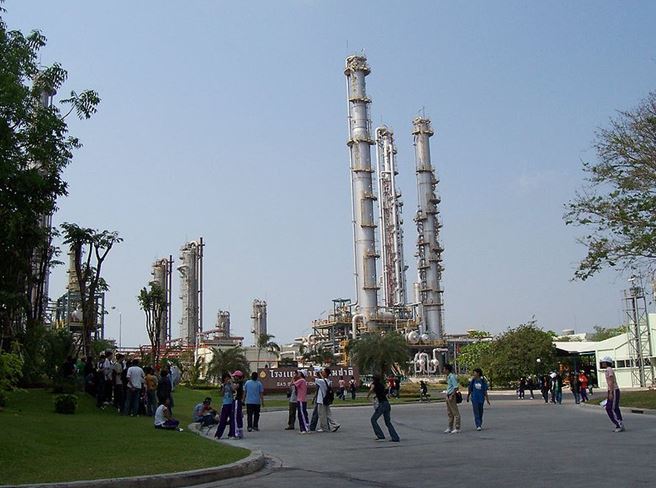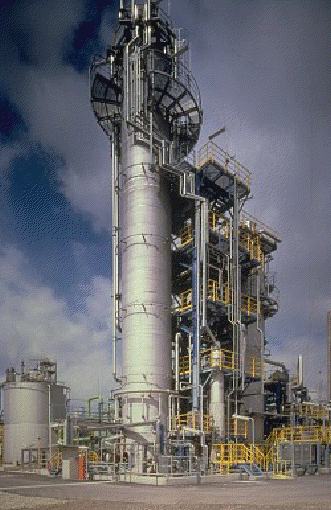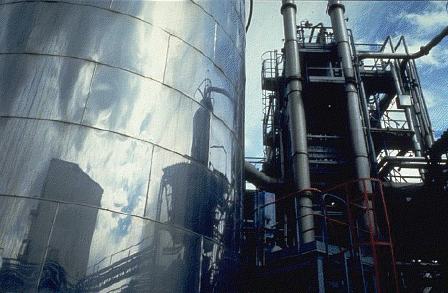.jpg) Pure hydrogen peroxide is a colourless liquid which is miscible with water. It is often supplied as a 40%(w/w) solution but is also obtainable up to ca 70%(w/w). It is used principally as a bleach.
Pure hydrogen peroxide is a colourless liquid which is miscible with water. It is often supplied as a 40%(w/w) solution but is also obtainable up to ca 70%(w/w). It is used principally as a bleach.
Uses of hydrogen peroxide
The bleaching properties of hydrogen peroxide are used in many industries. Perhaps its most familiar day-to-day use is in proprietary products used in washing clothes, for example in some forms of VanishTM. Large quantities of hydrogen peroxide are used to make sodium perborate and sodium percarbonate, which are used as bleaching agents in liquid and solid detergents. Sodium perborate, NaBO3.4H2O, is made by adding hydrogen peroxide to a solution of sodium metaborate and sodium hydroxide. Sodium percarbonate is prepared by adding hydrogen peroxide to a solution of sodium carbonate.
.jpg)
Figure 1 Uses of hydrogen peroxide.
| Figure 2 The kingfisher is able to feed in a previously polluted river which has been cleaned up by treating it with a solution of hydrogen peroxide. By kind permission of Solvay. |
.jpg) |
While its use in detergents accounts for large quantities of hydrogen peroxide, most is used in solution to bleach paper (increasing its brightness), wood pulp and fabrics. And recently, very large plants have come on stream in Antwerp (Belgium) and at the industrial complex at Map Ta Phut (Thailand). A third large plant is being built on the eastern seaboard of Saudi Arabia, on the Persian Gulf, at Jubail. All three plants will produce hydrogen peroxide which will be used to make epoxypropane (propylene oxide) by direct oxidation of propene. Epoxypropane will, in turn, be used principally to manufacture polyurethanes.
 |
| Figure 3 A view of the Man Ta Phut petrochemical complex on the Gulf of Thailand, close to the border with Cambodia, A plant to produce hydrogen peroxide has recently been commissioned in the complex. It is capable of producing over 330 000 tonnes of hydrogen peroxide a year, the largest such plant in the world. This photograph shows distillation towers used for the separation of alkanes from natural gas. The hydrogen needed to make hydrogen peroxide is derived from the methane in natural gas. By kind permission of Love Krittaya (Wikimedia Commons) |
Annual production of hydrogen peroxide
(expressed as H2O2 100%)
| World | 4.3 million tonnes1 |
| China | 1.5 million tonnes2 |
| US | 400 000 tonnes2 |
| Belgium | 300 000 tonnes2 |
| Thailand | 300 000 tonnes2 |
| Canada | 200 000 tonnes2 |
Data from:
1. Merchant Research and Consulting Ltd. 2015
2. Estimated from Merchant Research and Consulting Ltd. 2015
Manufacture of hydrogen peroxide
Over 99% of hydrogen peroxide is manufactured by an autoxidation process.
The main stages are:
a) hydrogenation of an anthraquinone
b) oxidation of the resulting anthraquinol
c) extraction of hydrogen peroxide solution
d) purification and concentration of hydrogen peroxide
| Figure 4 A view of a manufacturing plant for hydrogen peroxide in Leuna, near Leipzig in Germany. By kind permission of Arkema. |
 |
The Process
The reactions are summarized in Figure 4.
(a) Hydrogenation of an anthroquinone
The 2-ethyl derivative of anthraquinone is generally used in the process.
.jpg)
A solution of the 2-ethylanthraquinone in a mixed solvent system containing a non-polar hydrocarbon and a polar solvent, and a suspension of a nickel or palladium-based catalyst on a solid support, is hydrogenated using hydrogen gas at ca 320 K. Reduction to the 2- alkylanthraquinol occurs. The catalyst is removed by filtration and recycled.
(b) Oxidation of the anthraquinol
The solution of 2-ethylanthraquinol is then oxidized by air to a hydroperoxide, which reacts in water to reform 2-ethylanthraquinone and produce a dilute solution of hydrogen peroxide.
.jpg)
Figure 5 Manufacture of hydrogen peroxide using 2-ethylanthraquinone.
Thus the overall reaction is:
.jpg)
| Figure 6 The oxidiser unit for the production of hydrogen peroxide at Jarrie, south of Grenoble, France. By kind permission of Arkema. |
 |
(c) Extraction of hydrogen peroxide solution
Water is added to extract the peroxide as an aqueous solution containing 40% hydrogen peroxide. The organic solvent layer is recycled to the hydrogenation unit for further reaction.
(d) Purification and concentration of hydrogen peroxide
The aqueous hydrogen peroxide solution is treated with organic solvents and by air being pumped through to remove residual quinone and solvents and produce the standard 40% product. Some applications require higher concentration product which is produced by vacuum concentration or distillation to concentrations of up to 70%.
Hydrogen peroxide in its purest form is inherently stable. However, if brought into contact with certain contaminants (mainly heavy metals) it can decompose. Therefore, stabilisers are normally added to the product. They act by complexing with any traces of transition metal ions present which would otherwise catalyse the decomposition of hydrogen peroxide. Typical stabilisers are sodium stannate(IV) (which hydrolyzes to tin(IV) hydroxide) and various phosphates.
|
Date last amended: 6th November 2016

.jpg)